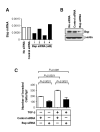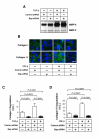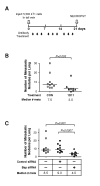Bone sialoprotein mediates the tumor cell-targeted prometastatic activity of transforming growth factor beta in a mouse model of breast cancer
- PMID: 16778210
- PMCID: PMC1528715
- DOI: 10.1158/0008-5472.CAN-06-0068
Bone sialoprotein mediates the tumor cell-targeted prometastatic activity of transforming growth factor beta in a mouse model of breast cancer
Abstract
Transforming growth factor betas (TGF-beta) play a dual role in carcinogenesis, functioning as tumor suppressors early in the process, and then switching to act as prometastatic factors in late-stage disease. We have previously shown that high molecular weight TGF-beta antagonists can suppress metastasis without the predicted toxicities. To address the underlying mechanisms, we have used the 4T1 syngeneic mouse model of metastatic breast cancer. Treatment of mice with a monoclonal anti-TGF-beta antibody (1D11) significantly suppressed metastasis of 4T1 cells to the lungs. When metastatic 4T1 cells were recovered from lungs of 1D11-treated and control mice, the most differentially expressed gene was found to be bone sialoprotein (Bsp). Immunostaining confirmed the loss of Bsp protein in 1D11-treated lung metastases, and TGF-beta was shown to regulate and correlate with Bsp expression in vitro. Functionally, knockdown of Bsp in 4T1 cells reduced the ability of TGF-beta to induce local collagen degradation and invasion in vitro, and treatment with recombinant Bsp protected 4T1 cells from complement-mediated lysis. Finally, suppression of Bsp in 4T1 cells reduced metastasis in vivo. We conclude that Bsp is a plausible mediator of at least some of the tumor cell-targeted prometastatic activity of TGF-beta in this model and that Bsp expression in metastases can be successfully suppressed by systemic treatment with anti-TGF-beta antibodies.
Figures







Similar articles
-
Differential Proteome Analysis Identifies TGF-β-Related Pro-Metastatic Proteins in a 4T1 Murine Breast Cancer Model.PLoS One. 2015 May 18;10(5):e0126483. doi: 10.1371/journal.pone.0126483. eCollection 2015. PLoS One. 2015. PMID: 25993439 Free PMC article.
-
An novel inhibitor of TGF-β type I receptor, IN-1130, blocks breast cancer lung metastasis through inhibition of epithelial-mesenchymal transition.Cancer Lett. 2014 Aug 28;351(1):72-80. doi: 10.1016/j.canlet.2014.05.006. Epub 2014 Jun 2. Cancer Lett. 2014. PMID: 24887560
-
Transcriptome profiling of a TGF-beta-induced epithelial-to-mesenchymal transition reveals extracellular clusterin as a target for therapeutic antibodies.Oncogene. 2010 Feb 11;29(6):831-44. doi: 10.1038/onc.2009.399. Epub 2009 Nov 23. Oncogene. 2010. PMID: 19935703
-
Mouse models of transforming growth factor beta impact in breast development and cancer.Endocr Relat Cancer. 2005 Dec;12(4):749-60. doi: 10.1677/erc.1.00936. Endocr Relat Cancer. 2005. PMID: 16322320 Review.
-
Transforming growth factor-beta and breast cancer: Lessons learned from genetically altered mouse models.Breast Cancer Res. 2000;2(2):100-6. doi: 10.1186/bcr41. Epub 2000 Feb 21. Breast Cancer Res. 2000. PMID: 11250699 Free PMC article. Review.
Cited by
-
Changes in Blood Biomarkers of Angiogenesis and Immune Modulation after Radiation Therapy and Their Association with Outcomes in Thoracic Malignancies.Cancers (Basel). 2021 Nov 16;13(22):5725. doi: 10.3390/cancers13225725. Cancers (Basel). 2021. PMID: 34830880 Free PMC article.
-
Role of TGF-β in breast cancer bone metastases.Adv Biosci Biotechnol. 2013 Oct 1;4(10C):15-30. doi: 10.4236/abb.2013.410A4003. Adv Biosci Biotechnol. 2013. PMID: 24558636 Free PMC article.
-
Silencing of atp6v1c1 prevents breast cancer growth and bone metastasis.Int J Biol Sci. 2013 Sep 5;9(8):853-62. doi: 10.7150/ijbs.6030. eCollection 2013. Int J Biol Sci. 2013. PMID: 24155661 Free PMC article.
-
Development and characterization of a preclinical model of breast cancer lung micrometastatic to macrometastatic progression.PLoS One. 2014 May 30;9(5):e98624. doi: 10.1371/journal.pone.0098624. eCollection 2014. PLoS One. 2014. PMID: 24878664 Free PMC article.
-
The Role of TGF-β Signaling Pathways in Cancer and Its Potential as a Therapeutic Target.Evid Based Complement Alternat Med. 2021 Jul 22;2021:6675208. doi: 10.1155/2021/6675208. eCollection 2021. Evid Based Complement Alternat Med. 2021. PMID: 34335834 Free PMC article. Review.
References
-
- Derynck R, Akhurst RJ, Balmain A. TGF-β signaling in tumor suppression and cancer progression. Nat Genet. 2001;29:117–29. - PubMed
-
- Gold LI. The role for transforming growth factor-β (TGF-β) in human cancer. Crit Rev Oncog. 1999;10:303–60. - PubMed
-
- Wakefield LM, Roberts AB. TGF-β signaling: positive and negative effects on tumorigenesis. Curr Opin Genet Dev. 2002;12:22–9. - PubMed
Publication types
MeSH terms
Substances
Grants and funding
LinkOut - more resources
Full Text Sources
Other Literature Sources

